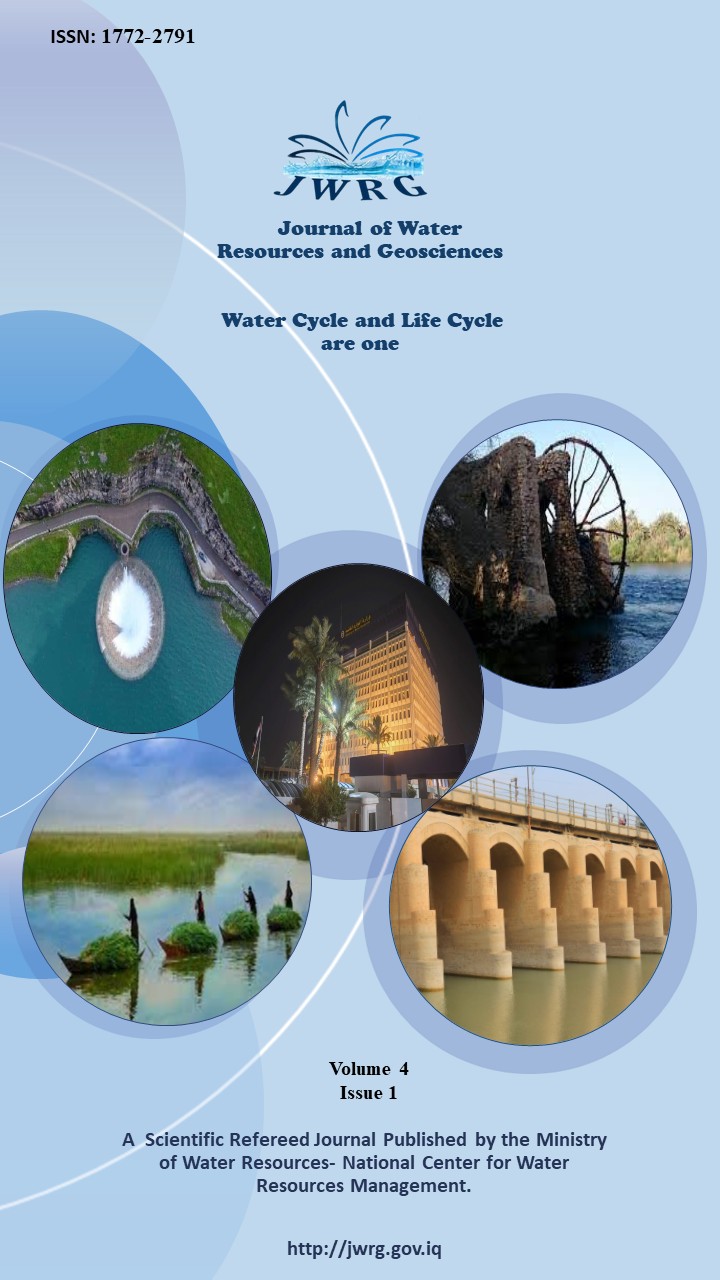The variations of PH and conductivity with time during the electrocoagulation process
Abstract
This study represents the performance of an electrocoagulation process employing a clear plastic reactor with holes in the aluminum plate electrodes to allow water to pass between the plates in a totoidal pattern. Regarding the efficiency of the process, the most important factors that affect the electrocoagulation process (EC) are electrical conductivity and pH. Continuous flow was carried out to evaluate the effects of different parameters on the pH, and conductivity variations. Two types of water are used in this study to investigate the use of electrocoagulation (EC): river water and discarded reverse osmosis system water. Using bipolar and monopolar aluminum electrodes, the factors that were examined were the flow rate (600, 1000 L/h) and the number of electrodes (2, 4). The pH showed oscillations throughout the various experimental circumstances for concentrated water, while for river water, the variation of pH and conductivity was stable. As for pH values, for river water, the pH increases and conductivity decreases for all experiments except for the 600L/h flow rate with reversing polarity experiment and employing two plates where the pH decreases and conductivity increases. For concentrated water, it is obvious through the experiments that the variation of pH and conductivity show unstable responses like that results from using river water because of the higher conductivity of the solution which leads to higher chemical reactions to occur during the experiments.
References
Ahmed, M. T., Chaabane, T., Maachi, R., & Darchen, A. (2012). Efficiency of a pretreatment by electrocoagulation with aluminum electrodes in a nanofiltration treatment of polluted water. Procedia Engineering, 33, 465–474. https://doi.org/10.1016/j.proeng.2012.01.1226
Al-Qodah, Z., & Al-Shannag, M. (2017). Heavy metal ions removal from wastewater using electrocoagulation processes: A comprehensive review. In Separation Science and Technology (Philadelphia) (Vol. 52, Issue 17, pp. 2649–2676). Taylor and Francis Inc. https://doi.org/10.1080/01496395.2017.1373677
Drogui, P., Blais, J.-F., Lekhlif, B., Oudrhiri, L., Zidane, F., Drogui, P., & Blais, J. F. (2014). Study of the electrocoagulation of electroplating industry wastewaters charged by nickel (II) and chromium (VI). J. Mater. Environ. Sci, 5(1), 111–120. https://www.researchgate.net/publication/279937813
Franco, D., Lee, J., Arbelaez, S., Cohen, N., & Kim, J. Y. (2017). Removal of phosphate from surface and wastewater via electrocoagulation. Ecological Engineering, 108, 589–596. https://doi.org/10.1016/j.ecoleng.2017.07.031
Golder, A. K., Hridaya, N., Samanta, A. N., & Ray, S. (2005). Electrocoagulation of methylene blue and eosin yellowish using mild steel electrodes. Journal of Hazardous Materials, 127(1–3), 134–140. https://doi.org/10.1016/j.jhazmat.2005.06.032
Gutiérrez-Bouzán, C., & Buscio, V. (2018). Combining electrochemistry and UV for the simultaneous wastewater decolorization and reduction of salinity. AIMS Environmental Science, 5(2), 96–104. https://doi.org/10.3934/environsci.2018.2.96
Hakizimana, J. N., Gourich, B., Vial, C., Drogui, P., Oumani, A., Naja, J., & Hilali, L. (2016). Assessment of hardness, microorganism and organic matter removal from seawater by electrocoagulation as a pretreatment of desalination by reverse osmosis. Desalination, 393, 90–101. https://doi.org/10.1016/j.desal.2015.12.025
Hu, C. Y., Lo, S. L., & Kuan, W. H. (2003). Effects of co-existing anions on fluoride removal in electrocoagulation (EC) process using aluminum electrodes. Water Research, 37(18), 4513–4523. https://doi.org/10.1016/S0043-1354(03)00378-6
Mameri, N., Yeddou, A. R., Lounici, H., Belhocine, D., Grib, H., & Bariou, B. (n.d.). DEFLUORIDATION OF SEPTENTRIONAL SAHARA WATER OF NORTH AFRICA BY ELECTROCOAGULATION PROCESS USING BIPOLAR ALUMINIUM ELECTRODES.
Mendez-Ruiz, J. I., Medina-Toala, A. N., Gutierrez, L., & Valverde-Armas, P. E. (2023). Comparative evaluation of an advanced electrocoagulation treatment system versus a conventional lime softening treatment for removing Ca2+, SO42−, and Mn in groundwater. Case Studies in Chemical and Environmental Engineering, 8, 100448. https://doi.org/10.1016/j.cscee.2023.100448
Moneer, A. A., El-Mallah, N. M., Ramadan, M. S., & Shaker, A. M. (2022). The effect of a novel electrode on the removal of Reactive Yellow 17 dye by Electrocoagulation technique. Egyptian Journal of Aquatic Research, 48(3), 191–197. https://doi.org/10.1016/j.ejar.2022.04.002
Mouedhen, G., Feki, M., De Petris-Wery, M., & Ayedi, H. F. (2009). Electrochemical removal of Cr(VI) from aqueous media using iron and aluminum as electrode materials: Towards a better understanding of the involved phenomena. Journal of Hazardous Materials, 168(2–3), 983–991. https://doi.org/10.1016/j.jhazmat.2009.02.117
Nugraheni, P. W., Maleiva, L. T. N., Ramadhan, F., Kusumawardhani, E., & Putra, L. S. A. (2023). Effectiveness of Well Water Treatment Method with Electrocoagulation, Coagulation, and Electrocoagulation-Coagulation Using Alum as Coagulant. IOP Conference Series: Earth and Environmental Science, 1228(1), 012039. https://doi.org/10.1088/1755-1315/1228/1/012039
Perren, W., Wojtasik, A., & Cai, Q. (2018). Removal of Microbeads from Wastewater Using Electrocoagulation. ACS Omega, 3(3), 3357–3364. https://doi.org/10.1021/acsomega.7b02037
Senathirajah, K., Kandaiah, R., Panneerselvan, L., Sathish, C. I., & Palanisami, T. (2023). Fate and transformation of microplastics due to electrocoagulation treatment: Impacts of polymer type and shape. Environmental Pollution, 334. https://doi.org/10.1016/j.envpol.2023.122159
Suryaningsih, N., Widayatno, T., Sugiharto, A., & Fuadi, A. M. (2021). The Effectivity of Aluminum Electrode for River Water Purification Using Electrocoagulation. IOP Conference Series: Materials Science and Engineering, 1053(1), 12130. https://doi.org/10.1088/1757-899x/1053/1/012130
Tampa Graduate Theses, U., USF Graduate Theses, D., Castro Carias, M., & Carias, C. (2022). Evaluation of Aluminum Dissolution, Current Density, and Pitting Evaluation of Aluminum Dissolution, Current Density, and Pitting Patterns During Electrocoagulation Patterns During Electrocoagulation.Scholar Commons Citation Scholar Commons Citation “Evaluation of Aluminum Dissolution, Current Density, and Pitting Patterns During Electrocoagulation” (2022). USF Tampa Graduate Theses and Dissertations.
Tchamango, S., Nanseu-Njiki, C. P., Ngameni, E., Hadjiev, D., & Darchen, A. (2010). Treatment of dairy effluents by electrocoagulation using aluminium electrodes. Science of the Total Environment, 408(4), 947–952. https://doi.org/10.1016/j.scitotenv.2009.10.026
Vepsäläinen, M. (n.d.). Electrocoagulation in the treatment of industrial waters and wastewaters.


